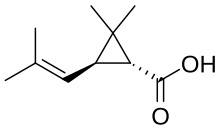Cyclopropanes are a family of organic compounds containing the cyclopropyl group. The parent is cyclopropane (C3H6).
Synthesis and reactions
Most cyclopropanes are not prepared from the parent cyclopropane, which is somewhat inert. Cyclopropyl groups are often prepared by cyclization of 1,3-difunctional alkanes. An example of the former, cyclopropyl cyanide is prepared by the reaction of 4-chlorobutyronitrile with a strong base.[1] Phenylcyclopropane is produced analogously from the 1,3-dibromide.[2]
A second major route to cyclopropanes entails addition of methylene (or its substituted derivatives) to an alkene, a process called cyclopropanation.[3]
Substituted cyclopropanes undergo the reactions associated with the cyclopropyl ring or the substituents. Vinylcyclopropanes are a special case as they undergo vinylcyclopropane rearrangement.
Applications and occurrence

Cyclopropane derivatives are numerous.[4] Many biomolecules and pharmaceutical drugs feature the cyclopropane ring. Famous example is aminocyclopropane carboxylic acid, which is the precursor to ethylene, a plant hormone.[5]
The pyrethroids are the basis of many insecticides.[6] Several cyclopropane fatty acids are known.

1-Aminocyclopropane-1-carboxylic acid plays an important role in the biosynthesis of the plant hormone ethylene.[5]
References
- ^ Schlatter, M. J. (1943). "Cyclopropyl Cyanide". Organic Syntheses. 23: 20. doi:10.15227/orgsyn.023.0020.
- ^ "Cyclopropylbenzene". Organic Syntheses. 44: 30. 1964. doi:10.15227/orgsyn.044.0030.
- ^ Maruoka, Keiji; Sakane, Soichi; Yamamoto, Hisashi (1989). "Selective Cyclopropanation of (S)-(−)-Perillyl Alcohol: 1-Hydroxymethyl-4-(1-Methylcyclopropyl)-1-Cyclohexene". Organic Syntheses. 67: 176. doi:10.15227/orgsyn.067.0176.
- ^ Rappoport, Zvi, ed. (1995). The Chemistry of the Cyclopropyl Group. The Chemistry of Functional Groups. Vol. 2. doi:10.1002/0470023481. ISBN 0471940747.
- ^ a b Kieber, Joseph J.; Schaller, G. Eric (2019-07-01). "Behind the Screen: How a Simple Seedling Response Helped Unravel Ethylene Signaling in Plants". The Plant Cell. 31 (7): 1402–1403. doi:10.1105/tpc.19.00342. ISSN 1040-4651. PMC 6635871. PMID 31068448.
- ^ Faust, Rüdiger (2001). "Fascinating Natural and Artificial Cyclopropane Architectures". Angewandte Chemie International Edition. 40 (12): 2251–2253. doi:10.1002/1521-3773(20010618)40:12<2251::AID-ANIE2251>3.0.CO;2-R. PMID 11433485.

